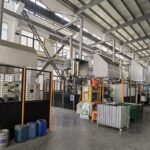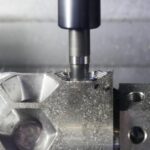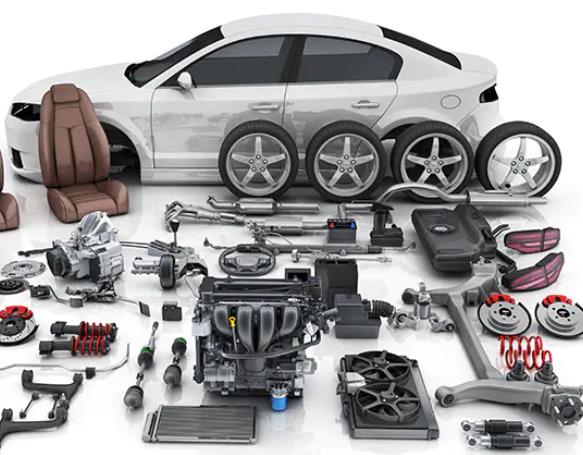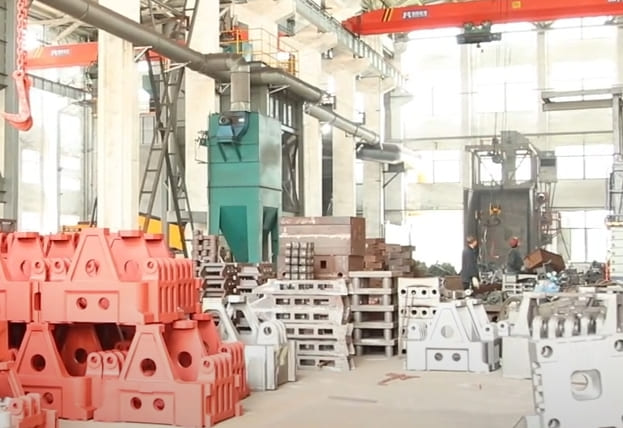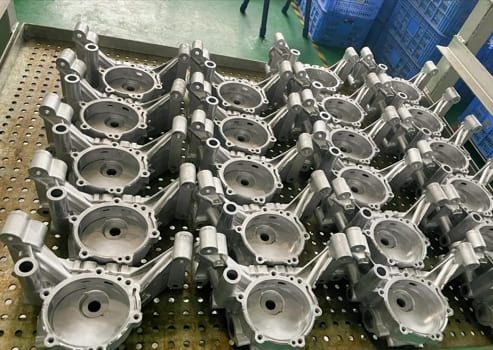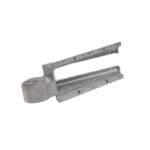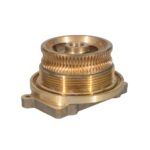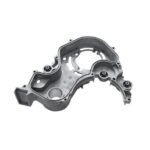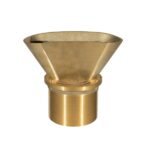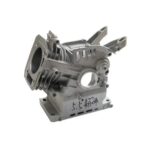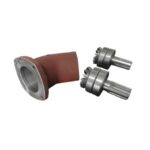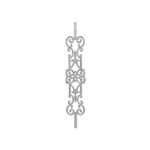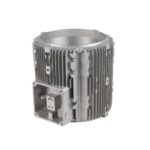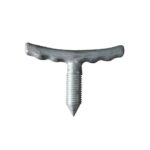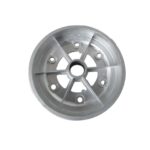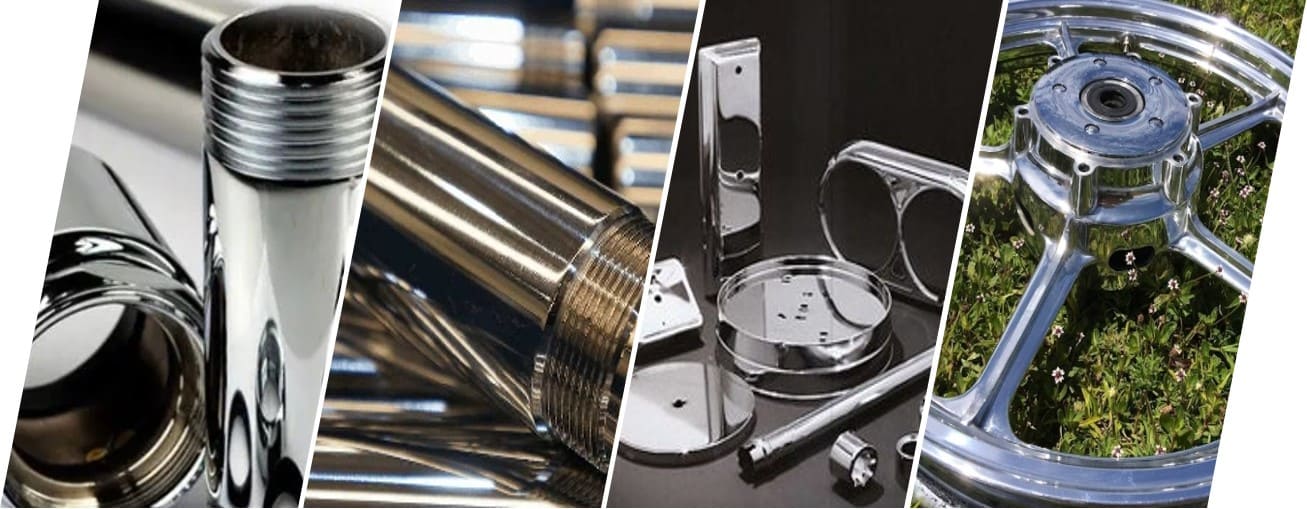
What Is Chrome Plating Aluminum?
Chrome plating aluminum is the electroplating of a thin chromium layer onto aluminum parts to improve appearance, corrosion resistance, or wear performance. Because aluminum forms a tough oxide that blocks adhesion, the chromium cannot be applied directly. A proven stack is zincate conversion of the aluminum surface → heavy copper strike and buff → nickel for brightness and corrosion → a thin chrome top-coat (decorative or hard chrome depending on duty).
Why it’s used
- Appearance: mirror-like, stable color (decorative chrome).
- Corrosion & tarnish control: nickel/chrome system protects the substrate.
- Wear & low friction: hard chrome (thicker) for sliding faces and tooling.
- Cleanability: smooth, low-roughness surface is easy to maintain.
Can You Chrome Plate Aluminum?
Yes. Chrome plating aluminum is reliable when you use an industrial pretreatment and a proven sequence: alkaline clean and de-smut → zincate (often double zincate) → heavy copper strike and intermediate buff → nickel for brightness and corrosion resistance → thin chrome top layer. Skipping steps leads to blisters, edge burning, or poor adhesion—especially on high-silicon die-cast grades such as A380/ADC12. DIY kits are not suitable for bare aluminum.
One-Screen Cheat Sheet
| What you need | Typical range (room temperature) | What it means |
|---|---|---|
| Decorative chrome thickness | 0.1–0.3 μm (over nickel) | Cosmetic finish; nickel does most of the corrosion work |
| Hard chrome thickness on aluminum | 5–50+ μm | Wear resistance; build in stages to manage stress |
| Surface hardness (hard chrome) | ~800–1000 HV | Very hard, low friction sliding faces |
| Polished roughness target | Mirror to ~Ra 0.2–0.4 μm | Achieved by copper leveling + buffing |
| Typical lead time | 1–3 weeks | Size, polishing, masking and rework dominate |
| Cost drivers | Plated area, geometry, polish, masking, rework | Specify racking plan and current-density window in RFQ |
How to Chrome Plate Aluminum: Step-by-Step
This is a practical, plain-English sequence that works for die-cast A380/ADC12, cast A356-T6, and wrought 6061-T6/6063-T5. Always validate on a sample.
1. Degrease and Alkaline Clean
Goal: remove oil, coolant and buffing wax so chemistry can wet the surface.
How: hot alkaline soak clean 2–5 min @ 50–70 °C with light agitation; follow with a spray or ultrasonic stage for complex shapes.
Check: water-break test—the film of rinse water should not bead or split.
If it fails: repeat clean; do not move to etch or zincate until the surface wets uniformly.
2. Rinse and De-Sm ut (Acid Deoxidize)
Goal: remove natural oxide and intermetallic “smut” (Si/Cu residues).
How: short de-ox 15–60 s @ room temp. For high-Si die castings, use a dedicated de-smut after a very light etch to avoid roughness.
Watch-outs: over-attack creates a dull, porous surface that is hard to level later.
3. First Zincate
Goal: convert the aluminum surface to a thin zinc film that accepts copper.
How: immerse 30–90 s @ room temp per chemistry supplier window.
Good sign: uniform satin-grey film.
If patchy: plan on a double zincate—strip and repeat.
4. Strip Zincate and Second Zincate (Double Zincate)
Why: the first zincate undercuts intermetallics; the second lays a more uniform film.
How: strip 5–15 s (nitric-based), rinse, zincate again 30–60 s.
Tip: look for an even, non-blotchy film; any shine-through areas predict adhesion trouble.
5. Copper Strike, Build and Buff
Goal: create a ductile, pore-sealing foundation that can be polished to mirror.
How: acid copper strike then build to 10–25 µm; keep current density in the mid-range to avoid edge burning.
Intermediate buff: polish the copper to reach Ra ≤ ~0.4 µm (or your cosmetic target). This is where the mirror is made.
Common mistake: thin strike directly to nickel → later peeling at edges or corners.
6. Nickel Plating on Aluminum
Goal: provide the real brightness and corrosion barrier.
How:
- Decorative stack: semi-bright nickel (ductile) → bright nickel (mirror).
- Structural base: thicker semi-bright nickel for lower stress and better fatigue behavior.
Build: 10–25 µm decorative baseline; more for demanding service.
Check: uniform gloss under controlled lighting; fix polishing only before chrome.
7. Chrome Plating on Aluminum
Decorative chrome: 0.1–0.3 µm as a thin, protective topcoat over nickel for color/tarnish resistance.
Hard chrome: 5–50+ µm for wear; deposit in stages and consider relief bakes to manage stress and micro-cracks.
Controls: current density, temperature and agitation; round edges and use thieves/shields to prevent edge burning and “dog-bone” build.
8. Rinse, Neutralize and Dry
Use counter-flow rinses between every stage; finish with DI rinse. Dry within 2 hours at low temperature to prevent “sweat stains.” Wrap with soft, non-chloride materials. If thick hard chrome was used, apply any required de-hydrogen bake per the process spec.
Typical Problems and Fast Fixes
- Blisters or peel within days: oxide was not fully removed or zincate compromised → redo double zincate; increase copper thickness; improve cleaning.
- Pitting that shows through: base porosity or poor clean → re-clean; heavier copper + buff; consider vacuum-assist casting on future parts.
- Grey or flat areas: poor current distribution → reposition racks, add auxiliary anodes or thieves, improve agitation.
- Edge burning: current too high or sharp geometry → lower current, radius edges, add shields.
Decorative vs Hard Chrome on Aluminum
| Attribute | Decorative Chrome on Aluminum | Hard Chrome on Aluminum |
|---|---|---|
| Primary purpose | Appearance + baseline corrosion | Wear resistance / low friction |
| Typical stack | Copper → Nickel (semi-bright + bright) → Chrome (thin) | Copper → Nickel (robust) → Chrome (thick) |
| Chrome thickness | 0.1–0.3 µm | 5–50+ µm |
| Hardness | Not primary driver | ~800–1000 HV |
| Best for | Trim, bezels, housings, instruments | Actuators, shafts, tooling wear faces |
| Cost and lead time | Low-mid | Mid-high (build in stages) |
Black Chrome on Aluminum: When to Use It
Black chrome gives a dark, premium look with fair corrosion protection when applied over a good Cu/Ni base. Color stability depends on the system; confirm gloss level and UV expectations during sampling. It’s popular for industrial design elements and controls where low glare is desired.
Chrome Plating Aluminum Data: Thickness, Hardness and Roughness
- Decorative chrome thickness: 0.1–0.3 µm (nickel carries brightness and most corrosion resistance).
- Hard chrome thickness: 5–50+ µm; deposit in stages and manage stress.
- Surface hardness: hard chrome ~800–1000 HV.
- Roughness after finish: mirror to ~Ra 0.2–0.4 µm if the copper is leveled and buffed properly.
- Dimensional impact: thickness adds; mask critical datums; specify allowable build on prints.
- Service life: driven by environment, thickness and prep quality—typically years in indoor duty; harsher outdoor service needs sealing, careful cleaners and maintenance.
Chrome Plating Aluminum by Alloy Grade
| Alloy / Temper | Plating behavior | What to specify |
|---|---|---|
| A380 / ADC12 (die-cast) | High silicon, micro-porosity; prone to pits and adhesion issues | Double zincate; robust copper (≥10–25 µm) and buff; consider vacuum-assist casting |
| A356-T6 (cast) | Generally cooperative; porosity varies with foundry practice | De-smut + double zincate; copper build then Ni/Cr |
| 6061-T6 (wrought) | Good cosmetic potential; stable adhesion | Standard zincate; polishing quality matters most |
| 6063-T5 (wrought) | Excellent for trim with fine surface | Standard route; tight buffing spec for mirror |
| 5052-H32 (wrought) | Usually fine; occasional smut | Standard zincate; control de-smut amount |
| 2024-T3 (wrought) | High copper; undercut risk; adhesion sensitive | Prefer double zincate; conservative current density; thicker copper base |
| 7075-T6 (wrought) | High Zn-Mg; adhesion sensitive; stress-crack risk at heavy builds | Double zincate; staged hard chrome; robust copper underplate |
Chrome Plating Defects on Aluminum and How to Prevent Them
- Adhesion failure: inadequate activation or zincate → repeat double zincate; check de-smut; avoid air-drying between steps.
- Edge burning and lumpy build: excessive current or sharp edges → round edges; reduce current; use thieves and shields.
- Pitting and pinholes: entrapped soils or base porosity → better clean; heavier copper leveling; ultrasonic assist.
- Dull or streaky appearance: poor copper polish or nickel imbalance → rebuff copper; verify nickel bath parameters.
EHS and Compliance for Chrome Plating Aluminum
Hexavalent-chromium processes are heavily regulated for worker exposure, fume capture and wastewater treatment. Many production lines use trivalent-chrome for decorative topcoats or run strict capture and treatment on hexavalent systems. Expect RoHS/REACH statements and wastewater documentation in your PPAP/FAI packs. Regulations are why people sometimes say chrome plating is “banned”—in practice, it’s regulated rather than universally prohibited.
Buyer RFQ Checklist for Chrome Plating Aluminum
Copy these items into your RFQ to speed quoting and reduce rework.
Material and appearance
- Alloy and temper (A380/ADC12, A356-T6, 6061-T6, 6063-T5, 2024-T3, 7075-T6, 5052-H32)
- Base finish (grit sequence, buff level, target Ra)
- Finish type: decorative chrome / hard chrome / black chrome
- Chrome thickness target and allowable dimensional growth
- Critical faces to mask; cosmetic face orientation and inspection distance
Process and quality
- Expect zincate → copper strike (heavy) → buff → nickel → chrome
- Copper and nickel thickness request; current-density window and racking plan
- Acceptance for pits/edge build; adhesion and salt-spray test names if required
Compliance and logistics
- Cr⁶⁺ or Cr³⁺ system disclosure; wastewater and ventilation compliance
- Packaging, handling and corrosion-in-transit expectations
- Sample approval plan (1st-article) and re-plate policy
Send your drawing and requirements—we’ll reply with a DFM + plating route, copper/nickel thickness plan, current-density window, and an indicative quote.



